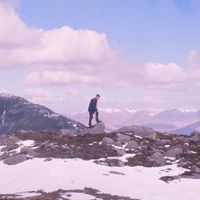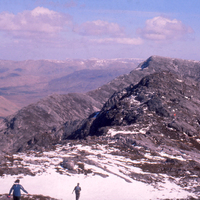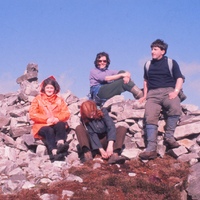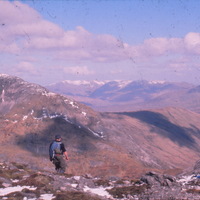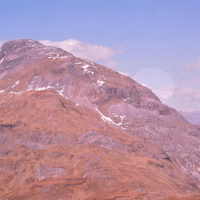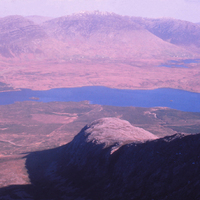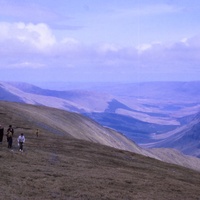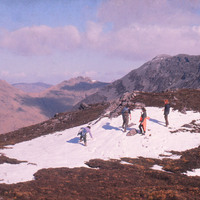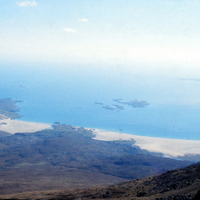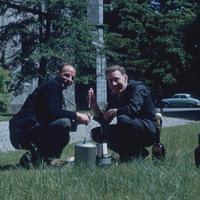Michael Kane's account of the Mountaineering Club c. 1971-1972
Item
Title
Format
Identifier
Description
Language
Bibliographic Citation
Relation
People mentioned
Places mentioned
Contributor
Publisher
Transcription
"Hill Walking at UCG 1971-1972
I think it is of interest to say something of the early history of UCG Mountaineering or Hill Walking Club. I will be talking mainly about 1970-1972. I joined UCG as a Junior Lecturer in the Autumn of 1970 and found there was a hill walking group which at the time was just a small collection of undergraduates and postgraduate students and an occasional lecturer. I started going on climbs every week. I think the major focus and possibly the origin of the group was the Zoology Department. There were 3 postgrads from the Zoology department in the climbing group, two of whom were Englishmen. One was Tony Whilde, who later became an ornithologist and a well-known environmentalist for the West of Ireland and the other was Richard Croome. Tony was probably one of the most experienced climbers in the group. The third graduate student from Zoology was Barbara Buckley.
Richard Croome fulfilled a very useful function in that he put up the club notices every week in the Quadrangle Archway (this was a very good place for club notices because at that time all human college life passed through the Archway). At the time, UCG was very small, consisting mainly of the Quad, Árus de Brún, the Engineering Buildings, the Anatomy Building and some terrapins. Richard Croome had a gift for drawing and his notices were usually adorned with humorous cartoons related to mountaineering. I remember one cartoon showing a climber asleep under a low ridge while a mountain goat was busy wolfing sandwiches from his open haversack behind him. Other members of the climbing group I remember were Richard Coughlan and Cecil O’Gorman, a Galway man, and a member of the family who owned O’Gorman’s bookshop (now Eason’s). Pat Sheeran, a later well-known literary figure, went hillwalking at times with us. Occasionally the Chief Technician in Physics, Frank Gaffney came out with us. Later on, we were joined by another Englishman, Dr John Woodley, a post doc in Biochemistry and Marie-Paule Pery a lectrice in the French Department (these two were to marry a few years later and I am still in touch with them). Sometimes some of my medical students in Physiology came out with the group.
We usually met for climbing trips outside the Archway in College at about 9:30 pm to 10 pm on a Sunday morning and usually did not return before 6 or 7 pm. There was a huge informality with the group’s organisation – I have no memory of ever signing up for anything - there was no membership list, no club officers. I think the climb for each week was probably decided mainly among the Zoology Department’s members and Richard’s notices in the Archway sufficed to spread the word. If you had a car, you brought it along prepared to transport any one that needed transporting. If you didn’t have a car, you came along anyway hoping to get a lift in someone’s car and almost never was anybody left behind. My own Austin Mini 1000 came in handy for transporting people to the various climbing spots – I often had up to 4 students plus myself packed into the tiny Mini. We used to go out most Sundays from the start of term at the beginning of October to the Spring and early Summer. Our numbers were usually small and we almost never had more than three cars going out.
Climbs in Connemara included mountains such as the Twelve Bens including what we called the Benlettery Horseshoe (officially known now as the Glencoaghan Horseshoe Loop Walk) because the six peaks on the Horseshoe started at Benlettery (see account of this climb below), Mweelrea, the Sheeffries etc. Occasionally we went on long distance trips such as to Kerry to climb mountains like Carrauntoohil.
Often when we started to climb in Connemara, it would be raining and at the start of many a climb, as I trudged through the muck and the slush and the bog at the bottom of a Connemara mountain, as a countryman I used to say to myself that I was mad to be doing this for pleasure! However, when we came near the top, very often (more often than not) the sun came out and dramatically changed one’s surroundings and one’s humour at the same time. At times my elation would be so great that on the return, I would run part of the way down the mountain – probably not too good for my hip joints in later life.
After our descent from the mountain, our first port of call was always a pleasant stop at a pub for a few drinks, at that time usually Peacocks at Maam Cross. It was only in later years that Keane’s Pub at Maam Bridge became the usual stop. This may have been because Peacocks began to look somewhat askance at six or eight climbers with muddy boots and sometimes muddy clothes coming into the pub! At the time, we didn't try to change clothes beforehand – small cars like the Austin Mini were a bit cramped!
Looking back, I have a very strong sense of how inexperienced, with some few exceptions, we were as a group. My first attempt at the Benlettery Horseshoe was nearly disastrous. I was one of a party of about six people, we got as far as the second peak Bengower when a heavy mist came down and we could only see about 8 to 12 feet in front of our noses. We tried to wait for the mist to clear but after some time decided it was better to head back to our cars. BIG PROBLEM - which way was back? - there were almost as many different opinions as there were people in the group. I was perhaps the least experienced person there so I kept quiet for a bit but I finally revealed that I actually had a COMPASS – the only person in the group to have a compass – this says something about how inexperienced the group was at the beginning. The only reason I had a compass was due to a very scary experience I had a few weeks previously when trying to climb Mweelrea with Frank Gaffney (the Chief Technician in the Physics Department) and I think Richard Coughlan. A very dense mist or fog came down and Frank, who had an uncanny sense of direction, brought us down safely. After that, I always brought a compass with me!
A Day on the Mountains in 1971 Twelve Bens Horseshoe, Benlettery to Derryclare (for Map see https://www.galwaytourism.ie/connemara/the-twelve-bens/)
Unlike my first attempt at the Horseshoe related above, the day pictured in the following pages was a fabulous day’s hill walking in the snow in the middle of Winter when a group of us from the UCG Climbing group, starting at Benlettery, climbed the six peaks of the Twelve Bens Horseshoe in sequence (peak heights in feet):- Benlettery (1827), Bengower (2178), Benbreen (2267), Bencollaghduff (2283), Bencorr (2333) and Derryclare (2221). It should be realised that in passing from one mountain peak to the next, we did not have to descend to ground level because peaks were connected by a ridge or saddle.
We left our cars at Benlettery. It was a bright sunny day with crisp sharp air – as I remember it a magical day. In places the ground was covered in snow but over much of the Horseshoe, the snow, except for areas in shade from the sun, had melted.
[illustration] Half Way Point - Ridge between Benbreen and Bencollaghduff
[illustration] As in previous but with Benbawn Highest Peak in the Twelve Bens to left of picture. Figures in both photos are Barbara Buckley and Tony Whilde.
[illustration] Michael Kane Standing on Ridge with Benbawn in Background to the Left
[illustration] Benbawn Highest Peak in the Twelve Bens in All Its Glory. Note Benbawn is not part of Horseshoe.
[illustration] A Well Earned Rest Stop for the Group
[illustration] Members of Group Playing in the Snow
[illustration] View of Derryclare Lough from Top of Derryclare
Walking the Horseshoe in the West to East Direction, Derryclare is the sixth and last peak. When we came down from Derryclare at the end of the Horseshoe, we had to foot it a number of miles back to our cars at Benlettery. A pint of beer at Peacocks of Maam Cross was very very welcome after our day’s walking."

